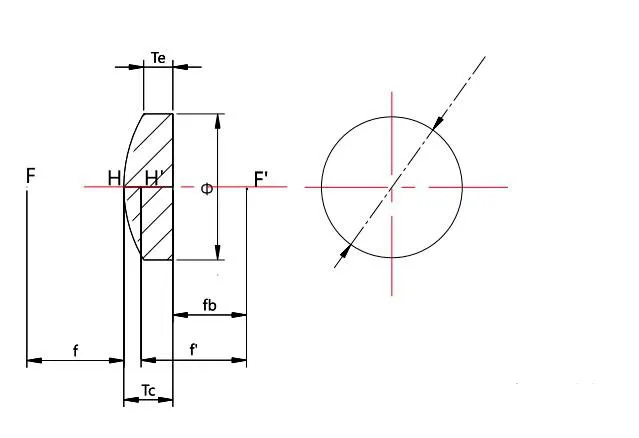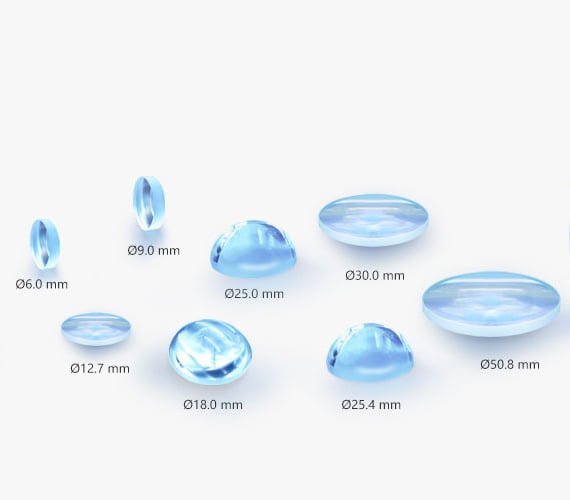Introduction
Convex lenses are integral parts of many optical devices such as cameras, telescopes and microscopes. Despite their widespread use, not everyone is familiar with their function. In this article, we will explain in detail what a convex lens is, how it works, the various types available, and the areas of application of convex lenses.

What Is a Convex Lens?
A convex lens, also known as a converging lens, focuses parallel light rays to a single point. These lenses are easily identifiable by their unique shape: they are thicker in the middle and taper towards the edges, which curve outward. When light passes through a convex lens, it bends (refracts) towards the principal axis, converging at a focal point.

The Converging Nature of Convex Lenses
The term “converging lens” stems from the lens’s ability to bring light rays together at a singular point along the primary axis. In contrast to concave lenses, which disperse light rays outward, convex lenses direct them inward, resulting in a concentrated beam of light.
Types of Convex Lenses
These lenses have one flat surface and one outwardly curved surface. Plano-convex lenses are ideal for applications requiring collimated light and are commonly used in robots and focusing optics.
Double Convex Lenses
Double convex, or bi-convex, lenses feature two outwardly curved surfaces. They have a shorter focal length compared to plano-convex lenses of the same size. These lenses are preferred for applications requiring longer focal lengths and are used in devices like projectors and cameras.
Concave-Convex Lenses
Also known as meniscus lenses, concave-convex lenses have one inwardly curved surface and one outwardly curved surface. These lenses are used to correct spherical aberrations in optical systems.
Applications of Convex Lenses
Cameras
In cameras, convex lenses focus and magnify images. By adjusting the position of these lenses, users can change the magnification and fine-tune the focal point, enhancing the clarity of images. Convex lenses are also used in webcams and video cameras.
Eyeglasses
Convex lenses are used to correct hyperopia (farsightedness), where the eye’s lens fails to focus light directly on the retina. These lenses help converge light rays onto the retina, improving near vision.
Peepholes
Peepholes in doors often contain convex lenses, which enlarge the view of the area outside the door. This allows residents to see who is outside without opening the door, enhancing security.
Microscopes
Optical microscopes use convex lenses to magnify small objects, such as microorganisms. By employing multiple lenses, microscopes can significantly increase the magnification, allowing for detailed examination of tiny structures.
Magnifying Glasses
A magnifying glass uses a convex lens to focus light on a single point, magnifying the object being viewed. When the object is within the focal length of the lens, it appears larger to the observer.
Projectors
Projectors use convex lenses to enlarge and project images or videos onto large screens. The lens system in a projector flips and magnifies the image, which is then displayed correctly when projected.
Refracting Telescopes
Refracting telescopes use convex lenses to view distant objects, such as planets. These telescopes typically employ two convex lenses: one to converge light rays and the other to magnify the image.
The Role of Convex Lenses in Photography
In the field of photography, convex lenses are crucial for capturing clear and focused images. The lens system in a camera directs light to converge on the film or image sensor, creating a sharp image. Photographers often use lenses with varying focal lengths to achieve different levels of magnification and field of view, enhancing their ability to capture detailed and wide-angle shots.
Convex Lenses in Scientific Research
Convex lenses are indispensable in scientific research, particularly in fields such as biology and physics. High-powered microscopes equipped with multiple convex lenses allow scientists to observe cellular structures and microorganisms in great detail. In physics, convex lenses are used in experiments to study light properties and optical phenomena, providing insights into the behavior of light and its interaction with various materials.

In Summary
Convex lenses play a vital role in various optical applications by converging light beams to a focal point. Their unique shape and functionality make them indispensable in devices ranging from everyday eyeglasses to advanced scientific instruments. Understanding the different types of convex lenses and their applications can help in selecting the right lens for specific needs.

